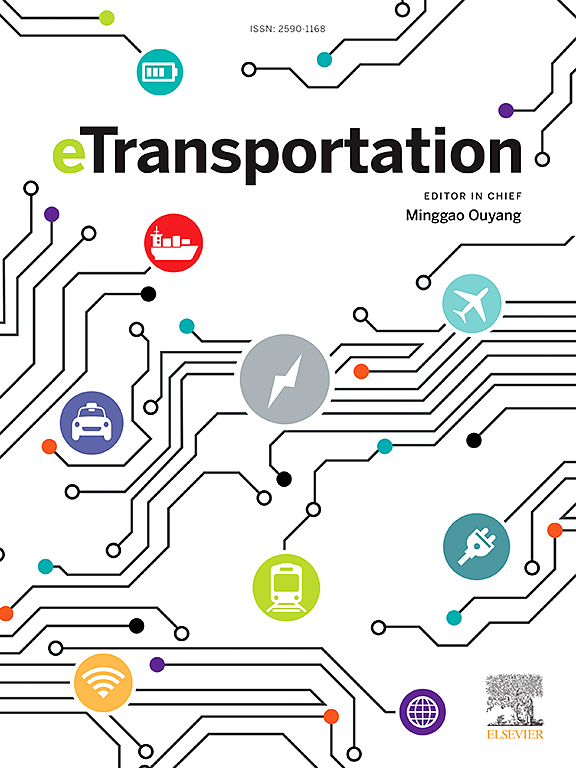Centralised vehicle-to-grid smart charging supported by PV generation for power variance minimisation at the transformer: A user’s perspective analysis
IF 17
1区 工程技术
Q1 ENERGY & FUELS
引用次数: 0
Abstract
Recent studies show that the electric vehicle (EV) fleet in the EU will reach 37–38 million units by 2035. Most of them are expected to be charged at home, boosting the number of residential charging stations to be installed. In order to decrease their environmental impact, these stations should be powered by clean energy sources, such as distributed photovoltaic (PV) generators. However, the increased penetration of EVs and PVs may cause large power supply and demand fluctuations, stressing the substation transformers. This paper proposes a centralised bidirectional Vehicle-to-Grid (V2G) smart EV charging policy minimising the net-load power variance (NLV) at the transformer. The proposed approach relies on the iterative solution of a Mixed-Integer Quadratically-Constrained Quadratic Programming (MIQCQP) problem that, unlike other research papers, keeps into account users’ charging/discharging requirements, and realistic charging limitations and efficiency. The impact of the resulting EV charging schedules is analysed at a district level for growing EV and PV penetration values, then compared with the results obtained with both unidirectional (V1G) and uncontrolled (UC) EV charging. Key elements of novelty of the work are: (i) the formalisation of the optimisation problem and its scalability potential, allowing for a multi-year analysis; (ii) an accurate assessment of the user self-sufficiency and the EV battery degradation by means of a physics-inspired model; (iii) an evaluation of the potential economic impact for EV owners over multiple years. Applying the proposed V2G strategy to battery electric vehicles (BEVs) reduces the NLV at the transformer by up to 80%, while increasing self-sufficiency by up to 23%, producing a minimal battery degradation. In the current market scenario, if the Distribution System Operator (DSO) offers a fair compensation for the V2G grid support, the potential yearly economic savings for battery electric vehicle (BEV) owners equipped with a residential PV generator range between 10% and 20%. This happens despite the higher V2G charging stations’ upfront costs and the faster BEV battery degradation.

集中式车辆到电网智能充电由光伏发电支持,在变压器处实现功率方差最小化:用户视角分析
最近的研究表明,到2035年,欧盟的电动汽车(EV)数量将达到3700万至3800万辆。预计其中大多数将在家中充电,这将增加住宅充电站的数量。为了减少对环境的影响,这些电站应该使用清洁能源供电,比如分布式光伏发电机。然而,电动汽车和光伏汽车普及率的提高可能会造成较大的电力供需波动,给变电站变压器带来压力。本文提出了一种中心化的车辆对电网(V2G)双向智能电动汽车充电策略,使变压器处的净负荷方差(NLV)最小化。该方法依赖于混合整数二次约束规划(MIQCQP)问题的迭代解,与其他研究论文不同,该方法考虑了用户的充放电要求,以及现实的充电限制和效率。在区域层面上分析了电动汽车和光伏电池渗透率不断增长对电动汽车充电计划的影响,并与单向(V1G)和非受控(UC)电动汽车充电的结果进行了比较。工作的新颖性的关键要素是:(i)优化问题的形式化及其可扩展性潜力,允许多年的分析;(ii)通过物理启发模型对用户自给自足和电动汽车电池退化进行准确评估;(iii)评估未来多年对电动汽车车主的潜在经济影响。将拟议的V2G策略应用于纯电动汽车(bev),可将变压器处的NLV降低高达80%,同时将自充率提高高达23%,从而产生最小的电池退化。在目前的市场情况下,如果配电系统运营商(DSO)为V2G电网支持提供公平的补偿,那么配备住宅光伏发电机的纯电动汽车(BEV)车主每年可能节省10%至20%的经济成本。尽管V2G充电站的前期成本更高,纯电动汽车电池的退化速度也更快,但这种情况还是发生了。
本文章由计算机程序翻译,如有差异,请以英文原文为准。
求助全文
约1分钟内获得全文
求助全文
来源期刊

Etransportation
Engineering-Automotive Engineering
CiteScore
19.80
自引率
12.60%
发文量
57
审稿时长
39 days
期刊介绍:
eTransportation is a scholarly journal that aims to advance knowledge in the field of electric transportation. It focuses on all modes of transportation that utilize electricity as their primary source of energy, including electric vehicles, trains, ships, and aircraft. The journal covers all stages of research, development, and testing of new technologies, systems, and devices related to electrical transportation.
The journal welcomes the use of simulation and analysis tools at the system, transport, or device level. Its primary emphasis is on the study of the electrical and electronic aspects of transportation systems. However, it also considers research on mechanical parts or subsystems of vehicles if there is a clear interaction with electrical or electronic equipment.
Please note that this journal excludes other aspects such as sociological, political, regulatory, or environmental factors from its scope.
 求助内容:
求助内容: 应助结果提醒方式:
应助结果提醒方式:


